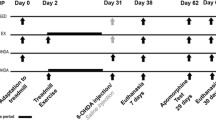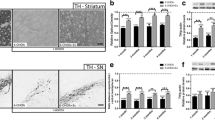Abstract
Exercise can act as a disease-modifying agent in Parkinson’s disease (PD), and we have previously demonstrated that voluntary exercise in running wheels during 2 weeks normalizes striatopallidal dopaminergic signaling and prevents the development of l-DOPA-induced dyskinesia (LID) in C57BL/6 mice. We now tested whether LID in Swiss albino mice could be attenuated by treadmill-controlled exercise alone or in combination with the reference antidyskinetic drug amantadine. The daily intraperitoneal (i.p.) treatment with three different doses of l-DOPA/benserazide (30/12.5, 50/25, or 70/35 mg/kg) during 3 weeks induced increasing levels of LID scores in hemiparkinsonian Swiss albino mice previously lesioned with a unilateral intrastriatal injection of 6-hydroxydopamine (6-OHDA, 10 μg). Then, we addressed the antidyskinetic effects of treadmill-controlled exercise by comparing LID, induced by l-DOPA/benserazide (50/25 mg/kg, i.p.) during 4 weeks, in sedentary and daily exercised mice. Exercise reduced LID and improved motor skills of dyskinetic mice, as indicated by decreased contralateral bias, increase in maximal load test, and latency to fall in rotarod. The antidyskinetic effect of amantadine (60 mg/kg, i.p.) was only observed in sedentary mice, indicating the absence of synergistic antidyskinetic effect of the combination of treadmill exercise plus amantadine. Finally, Western blot analysis unraveled an ability of exercise to increase the striatal immunocontent of glial cell-derived neurotrophic factor (GDNF), apart from normalizing striatal levels of tyrosine hydroxylase. These findings show that controlled treadmill exercise attenuates LID and provide the first indication that the antidyskinetic effects of treadmill exercise may involve increased striatal GDNF levels.



Similar content being viewed by others
References
Cenci MA (2017) Molecular mechanisms of L-DOPA-induced dyskinesia. Handb Behav Neurosci 24:857–871
Carta M, Bezard E (2011) Contribution of pre-synaptic mechanisms to L-DOPA-induced dyskinesia. Neuroscience 198:245–251
Aguiar AS, Lopes SC, Tristão FSM, Rial D, de Oliveira G, da Cunha C, Raisman-Vozari R, Prediger RD (2016) Exercise improves cognitive impairment and iopamine metabolism in MPTP-treated mice. Neurotox Res 29:118–125
Aguiar AS Jr, Araújo AL, da-Cunha TR et al (2009) Physical exercise improves motor and short-term social memory deficits in reserpinized rats. Brain Res Bull 79:452–457
Fisher BE, Petzinger GM, Nixon K, Hogg E, Bremmer S, Meshul CK, Jakowec MW (2004) Exercise-induced behavioral recovery and neuroplasticity in the 1-methyl-4-phenyl-1,2,3,6-tetrahydropyridine-lesioned mouse basal ganglia. J Neurosci Res 77:378–390
Toy WA, Petzinger GM, Leyshon BJ, Akopian GK, Walsh JP, Hoffman MV, Vučković MG, Jakowec MW (2014) Treadmill exercise reverses dendritic spine loss in direct and indirect striatal medium spiny neurons in the 1-methyl-4-phenyl-1,2,3,6-tetrahydropyridine (MPTP) mouse model of Parkinson’s disease. Neurobiol Dis 63:201–209
Aguiar AS, Moreira ELG, Hoeller AA et al (2013) Exercise attenuates levodopa-induced dyskinesia in 6-hydroxydopamine-lesioned mice. Neuroscience 243:46–53
Klemann CJHM, Xicoy H, Poelmans G, Bloem BR, Martens GJM, Visser JE (2018) Physical exercise modulates L-DOPA-regulated molecular pathways in the MPTP mouse model of Parkinson’s disease. Mol Neurobiol 55:5639–5657
Wu S-Y, Wang T-F, Yu L, Jen CJ, Chuang JI, Wu FS, Wu CW, Kuo YM (2011) Running exercise protects the substantia nigra dopaminergic neurons against inflammation-induced degeneration via the activation of BDNF signaling pathway. Brain Behav Immun 25:135–146
Cohen AD, Tillerson JL, Smith AD, Schallert T, Zigmond MJ (2003) Neuroprotective effects of prior limb use in 6-hydroxydopamine-treated rats: possible role of GDNF. J Neurochem 85:299–305
Sopova K, Gatsiou K, Stellos K, Laske C (2014) Dysregulation of neurotrophic and haematopoietic growth factors in Alzheimer’s disease: from pathophysiology to novel treatment strategies. Curr Alzheimer Res 11:27–39
d’Anglemont de Tassigny X, Pascual A, Lopez-Barneo J (2015) GDNF-based therapies, GDNF-producing interneurons, and trophic support of the dopaminergic nigrostriatal pathway. Implications for Parkinson’s disease. Front Neuroanat 9:10
da Conceição FSL, Ngo-Abdalla S, Houzel J-C, Rehen SK (2010) Murine model for Parkinson’s disease: from 6-OH dopamine lesion to behavioral test. J Vis Exp 35:1376
Nishimura F, Yoshikawa M, Kanda S, Nonaka M, Yokota H, Shiroi A, Nakase H, Hirabayashi H et al (2003) Potential use of embryonic stem cells for the treatment of mouse parkinsonian models: improved behavior by transplantation of in vitro differentiated dopaminergic neurons from embryonic stem cells. Stem Cells 21:171–180
Pavón N, Martín AB, Mendialdua A, Moratalla R (2006) ERK phosphorylation and FosB expression are associated with L-DOPA-induced dyskinesia in hemiparkinsonian mice. Biol Psychiatry 59:64–74
Jiang C, Wan X, Jankovic J, Christian ST, Pristupa ZB, Niznik HB, Sundsmo JS, le W (2004) Dopaminergic properties and experimental anti-parkinsonian effects of IPX750 in rodent models of Parkinson disease. Clin Neuropharmacol 27:63–73
Cenci MA (2007) Dopamine dysregulation of movement control in L-DOPA-induced dyskinesia. Trends Neurosci 30:236–243
Santini E, Valjent E, Usiello A, Carta M, Borgkvist A, Girault JA, Herve D, Greengard P et al (2007) Critical involvement of cAMP/DARPP-32 and extracellular signal-regulated protein kinase signaling in L-DOPA-induced dyskinesia. J Neurosci 27:6995–7005
Wolf E, Seppi K, Katzenschlager R, Hochschorner G, Ransmayr G, Schwingenschuh P, Ott E, Kloiber I et al (2010) Long-term antidyskinetic efficacy of amantadine in Parkinson’s disease. Mov Disord 25:1357–1363
Frazzitta G, Bertotti G, Morelli M, Riboldazzi G, Pelosin E, Balbi P, Boveri N, Comi C et al (2012) Rehabilitation improves dyskinesias in parkinsonian patients: a pilot study comparing two different rehabilitative treatments. NeuroRehabilitation 30:295–301
Frazzitta G, Morelli M, Bertotti G et al (2012) Intensive rehabilitation treatment in parkinsonian patients with dyskinesias: a preliminary study with 6-month followup. Parkinsons Dis 2012:4–7
Mantri S, Fullard ME, Duda JE, Morley JF (2018) Physical activity in early Parkinson disease. J Parkinsons Dis 8:107–111
Aguiar ASJ, Duzzioni M, Remor AP et al (2016) Moderate-intensity physical exercise protects against experimental 6-hydroxydopamine-induced hemiparkinsonism through Nrf2-antioxidant response element pathway. Neurochem Res 41:64–72
Huang L, Deng M, Zhang S, Lu S, Gui X, Fang Y (2017) β-Asarone and levodopa coadministration increases striatal levels of dopamine and levodopa and improves behavioral competence in Parkinson’s rat by enhancing dopa decarboxylase activity. Biomed Pharmacother 94:666–678
Petzinger GM, Walsh JP, Akopian G, Hogg E, Abernathy A, Arevalo P, Turnquist P, Vuckovic M et al (2007) Effects of treadmill exercise on dopaminergic transmission in the 1-methyl-4-phenyl-1,2,3,6-tetrahydropyridine-lesioned mouse model of basal ganglia injury. J Neurosci 27:5291–5300
Lindgren N, Leak RK, Carlson KM, Smith AD, Zigmond MJ (2008) Activation of the extracellular signal-regulated kinases 1 and 2 by glial cell line-derived neurotrophic factor and its relation to neuroprotection in a mouse model of Parkinson’s disease. J Neurosci Res 86:2039–2049
Aoi M, Date I, Tomita S, Ohmoto T (2000) The effects of intrastriatal single injection of GDNF on the nigrostriatal dopaminergic system in hemiparkinsonian rats: behavioral and histological studies using two different dosages. Neurosci Res 36:319–325
Iravani MM, Costa S, Jackson MJ, Tel BC, Cannizzaro C, Pearce RKB, Jenner P (2001) GDNF reverses priming for dyskinesia in MPTP-treated, L-DOPA-primed common marmosets. Eur J Neurosci 13:597–608
Funding
This work was supported by grants from Conselho Nacional de Desenvolvimento Científico e Tecnológico (CNPq, Universal 408676/2016-7), Coordenação de Aperfeiçoamento de Pessoal de Nível Superior (CAPES-FCT), Programa de Apoio aos Núcleos de Excelência (PRONEX-Project NENASC), and Fundação de Apoio à Pesquisa do Estado de Santa Catarina (FAPESC). MS received scholarships from CNPq, and AES received scholarship from FAPESC/CAPES. ASA and RDP are supported by research fellowships from CNPq.
Author information
Authors and Affiliations
Corresponding author
Ethics declarations
All experimental protocols were approved by the Institutional Animal Care and Use Committee (IACUC) of UFSC (protocol PP00357).
Conflict of Interest
The authors declare that they have no conflict of interest.
Electronic Supplementary Material
ESM 1
(WMV 7410 kb)
Rights and permissions
About this article
Cite this article
Speck, A.E., Schamne, M.G., S. Aguiar, A. et al. Treadmill Exercise Attenuates l-DOPA-Induced Dyskinesia and Increases Striatal Levels of Glial Cell-Derived Neurotrophic Factor (GDNF) in Hemiparkinsonian Mice. Mol Neurobiol 56, 2944–2951 (2019). https://doi.org/10.1007/s12035-018-1278-3
Received:
Accepted:
Published:
Issue Date:
DOI: https://doi.org/10.1007/s12035-018-1278-3




